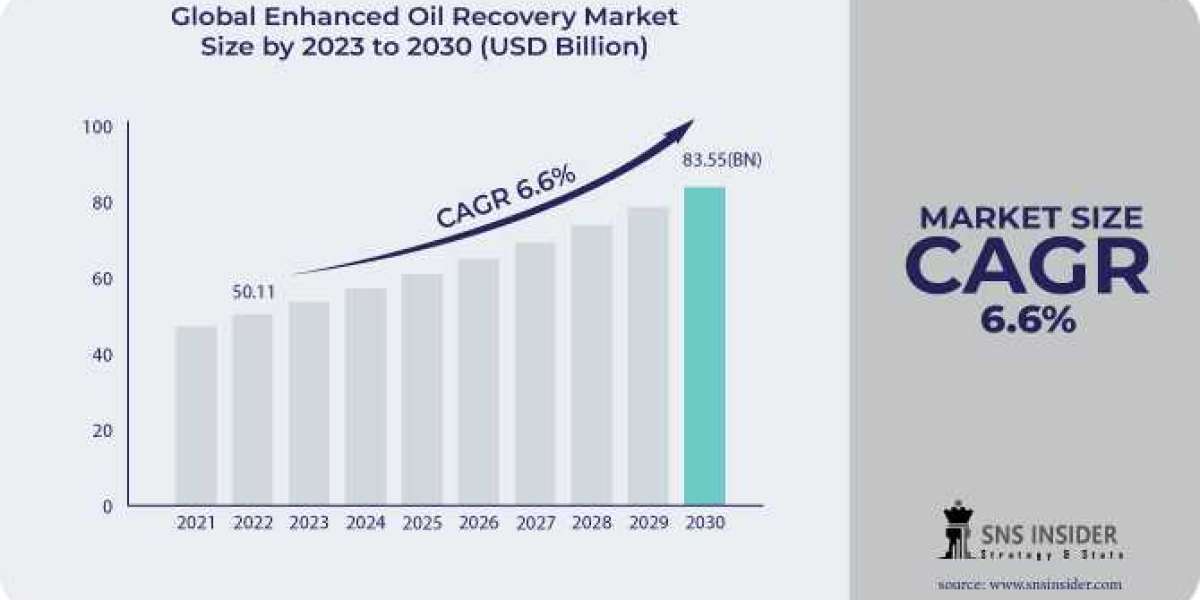The Enhanced Oil Recovery Market size was valued at USD 53.51 billion in 2023 and is expected to grow to USD 90.58 billion by 2031 and grow at a CAGR of 6.8 % over the forecast period of 2024–2031.
Market Overview
Enhanced Oil Recovery (EOR) refers to the techniques used to increase the amount of crude oil that can be extracted from an oil field, beyond what is achieved by primary and secondary recovery methods. With the global oil demand continuing to rise, there is increasing focus on maximizing the recovery from existing oil reservoirs, especially as many mature fields begin to decline in production. EOR techniques are essential for improving oil yield from these fields, making them economically viable for longer periods.
The EOR market is evolving rapidly, with technological innovations playing a key role in improving efficiency, reducing costs, and enhancing environmental sustainability. Thermal, chemical, and gas EOR methods, along with newer techniques such as microbial and seismic EOR, are gaining traction in various regions, supported by increased investments in research and development.
Key Market Segmentation
The Enhanced Oil Recovery (EOR) Market is segmented by technology, application, and region.
By Technology
- Thermal EOR: Thermal EOR is one of the most widely used techniques for increasing oil production, particularly in heavy oil reservoirs. This method involves injecting steam into the reservoir to reduce the viscosity of the oil, making it easier to extract. Thermal EOR is predominantly used in onshore oil fields with heavy and viscous crude oil.
- Chemical EOR: In chemical EOR, chemicals such as surfactants, polymers, and alkalis are injected into the reservoir to alter the properties of the oil and improve recovery. This technique is highly effective in reservoirs with low permeability or high viscosity and is commonly used in both onshore and offshore applications.
- Gas EOR: Gas EOR involves injecting gases such as carbon dioxide (CO2), nitrogen, or natural gas into oil reservoirs to improve oil recovery. CO2 EOR is particularly popular because it not only enhances oil recovery but also offers a potential solution for carbon sequestration, which contributes to sustainability goals.
- Others (Microbial, Seismic, Simultaneous Water Alternating Gas, and Water Alternating Gas): These are emerging techniques that focus on improving oil recovery by utilizing innovative methods:
- Microbial EOR uses microbes to enhance oil recovery by reducing the oil’s viscosity or by producing gases that aid in extraction.
- Seismic EOR uses advanced seismic technologies to improve the understanding of reservoir dynamics, leading to more targeted and efficient recovery efforts.
- Simultaneous Water Alternating Gas (SWAG) and Water Alternating Gas (WAG) combine the benefits of water flooding and gas injection, allowing for more efficient oil displacement and recovery in complex reservoirs.
By Application
- Onshore: Onshore oil fields are the primary locations for EOR activities, particularly for thermal and chemical EOR. With a large number of aging oil fields, onshore sites are increasingly adopting EOR methods to extend the production life of these fields.
- Offshore: Offshore oil fields, although typically more expensive to develop and operate, are also adopting EOR methods, particularly gas injection and chemical EOR techniques, to enhance oil recovery. As offshore fields mature, EOR techniques are becoming crucial for maintaining and improving oil yields.
By Region
- North America: North America, particularly the United States, has been a major player in the adoption of EOR techniques, especially CO2 flooding for enhanced recovery. Texas, California, and other oil-rich states have extensive oil fields utilizing EOR methods. Additionally, environmental concerns regarding carbon emissions are driving the growth of CO2 EOR projects in the region.
- Europe: In Europe, EOR adoption is primarily seen in the North Sea, with countries like the UK and Norway leading the way in utilizing gas injection and chemical methods for enhanced recovery. The region is also exploring newer EOR technologies such as microbial EOR to improve oil recovery in mature fields.
- Asia-Pacific: The Asia-Pacific region, with its large untapped reserves and growing demand for energy, is expected to witness significant growth in the EOR market. Countries like China, India, and Indonesia are increasingly investing in EOR techniques to optimize the production from their aging oil fields.
- Latin America: Latin America, especially Brazil and Venezuela, is another region where EOR methods are seeing increased adoption due to large-scale oil fields and the need to maximize recovery from existing reservoirs. The region is also exploring the potential of CO2 EOR as a method to enhance production and support environmental goals.
- Middle East Africa: The Middle East, with its large reserves of oil, has been slow to adopt EOR techniques due to the availability of cheap, easily recoverable oil. However, as reserves deplete, countries in the region are beginning to invest in EOR methods, particularly gas injection and water alternating gas methods, to sustain production levels.
Market Trends and Growth Drivers
- Increasing Oil Demand: As global oil demand continues to rise, there is an increasing need for innovative methods to optimize production from existing fields. EOR techniques provide a sustainable solution to meet growing energy needs while extending the life of mature fields.
- Technological Advancements: Ongoing technological innovations in EOR methods are improving the efficiency and cost-effectiveness of recovery techniques. From chemical formulations to the use of CO2 for carbon sequestration, advancements are shaping the future of the EOR market.
- Environmental Sustainability: EOR technologies, especially CO2 injection, are becoming more popular due to their potential to reduce the carbon footprint of oil production. This is encouraging the adoption of these methods in a world that is increasingly focused on sustainable energy solutions.
- Aging Oil Fields: As many of the world’s major oil fields mature, EOR methods are becoming essential for maximizing oil extraction and maintaining production levels. This is especially true in onshore fields, where primary and secondary recovery methods no longer yield sufficient output.
- Investment in Research and Development: Companies are increasingly investing in RD to discover new and more efficient EOR methods, including microbial and seismic EOR, to address the challenges faced in mature and complex oil reservoirs.
Read Complete Report Details of Enhanced Oil Recovery Market Size 2024–2031@
https://www.snsinsider.com/reports/gas-turbine-services-market-3299
Conclusion
The Enhanced Oil Recovery (EOR) Market is expected to grow substantially from 2024 to 2031, driven by increasing energy demand, technological advancements, and a focus on maximizing oil production from existing fields. EOR techniques, particularly thermal, chemical, and gas EOR, will continue to play a critical role in enhancing recovery from aging oil fields, while emerging methods like microbial and seismic EOR offer additional growth opportunities. As the global oil and gas industry faces new challenges, EOR will remain a key strategy for optimizing resource extraction and ensuring energy security.
About Us:
SNS Insider is a global leader in market research and consulting, shaping the future of the industry. Our mission is to empower clients with the insights they need to thrive in dynamic environments. Utilizing advanced methodologies such as surveys, video interviews, and focus groups, we provide up-to-date, accurate market intelligence and consumer insights, ensuring you make confident, informed decisions.
Contact Us:
Akash Anand — Head of Business Development Strategy
info@snsinsider.com
Phone: +1–415–230–0044 (US) | +91–7798602273 (IND)














